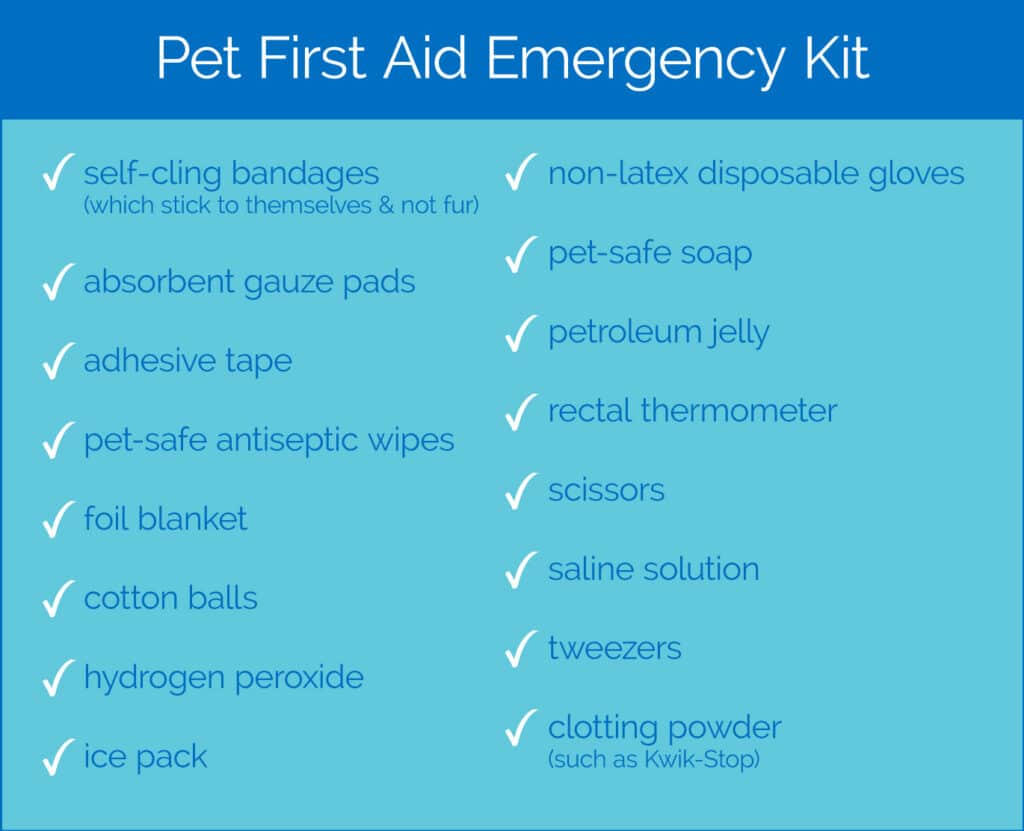In a pet emergency, those first few minutes are crucial and may require advanced care and know-how on your part to protect your pet and maybe even keep them alive.
Let’s review what classifies as a pet emergency and some first aid preparedness tips you should know for before you call the vet.
Pet Emergencies that Require Immediate Veterinary Consultation or Care
What constitutes a pet emergency that needs immediate veterinary attention? According to the American Veterinary Medical Association, here are 13 pet emergencies that you should call your vet or animal urgent care provider about immediately:
- Severe bleeding or bleeding that doesn’t stop within five minutes
- Choking, difficulty breathing or nonstop coughing and gagging
- Bleeding from nose, mouth, rectum, coughing up blood, or blood in urine
- Inability to urinate or pass feces (stool), or obvious pain associated with urinating or passing stool
- Injuries to your pet’s eye(s)
- You suspect or know your pet has eaten something poisonous (such as antifreeze, xylitol, chocolate, rodent poison, etc.)
- Seizures and/or staggering
- Fractured bones, severe lameness or inability to move leg(s)
- Obvious signs of pain or extreme anxiety
- Heat stress or heatstroke
- Severe vomiting or diarrhea – more than two episodes in a 24-hour period, or either of these combined with obvious illness or any of the other problems listed here
- Refusal to drink for 24 hours or more
- Unconsciousness
If your pet is experiencing any of these life-threatening emergencies, call us immediately at 701-757-3500. If this happens to your pet between 10 PM and 7 AM daily, please call our after-hours referral, Red River Animal Emergency Hospital & Referral Center located in Fargo, ND, at 701-478-9299.
Pet First Aid Preparedness
Being prepared for a pet emergency is crucial to keeping your pet safe and helping you stay calm if faced with an urgent health situation. Here are some tools to have on hand and some common urgent care situations to educate yourself on to help keep your pet safe.
Pet First Aid Emergency Kit
Having an emergency first aid kit in your home is not just for humans. Keep an emergency first aid kit handy for your pet’s specific needs separately, too, so that you have everything you need in case of an emergency.

Toxins and Poisons
When it comes to poisons and your pet, a good rule of thumb is that if it is hazardous to you, it is also toxic to your pet. However, there are also plenty of human-safe foods and products that are poisonous to your pets, including chocolate, lilies, grapes, Xylitol (found in peanut butter), and these common household items and plants.
If your pet’s eyes have been exposed to a toxin and the label tells you to flush them with water, do this as soon as possible. If their skin has been affected, the label may say to wash with soap and water, and this should be done with pet-safe soap as quickly as possible, while avoiding getting soap into your pet’s eyes, mouth, or nose.
Consuming poisonous substances can be very harmful to your pet and may cause:
- Seizures
- Loss of consciousness
- Difficulty breathing
If your pet has experienced any of these symptoms, call us at 701-757-3500 or the ASPCA Poison Control Hotline at 888-426-4435 right away.
Seizures
Seizures can be very traumatic for both you and your pet, but it is important to remain calm and keep pets away from anything that may hurt them while they are seizing. Do not try to restrain your pet, as this may cause injury to both them and you.
It is helpful to time the seizure and report the length to your veterinarian for diagnosis. Once the seizure has stopped, make sure to keep your pet warm and try to calm them if possible.
Bleeding
If there is external bleeding, use a clean gauze pad or cloth and apply firm pressure to the wound until it starts to clot. This may take several minutes and checking it often will slow the progression, instead hold pressure for a minimum of three minutes before checking for a clot.
If the bleeding is on an extremity, you should apply a makeshift tourniquet first and follow the steps above. Make sure to get your pet to the veterinarian immediately if there is severe bleeding, as this can quickly become life-threatening.
If your pet is showing symptoms of internal bleeding, keep them warm and calm and go to your veterinarian as soon as possible.


Heatstroke
During seasons of warmer weather, it is important to monitor your pet extra closely. Never leave your pet in the car on a warm day, and always limit their exposure to direct sunlight.
If your pet shows signs of heatstroke, move them to a cool spot and place a wet, cold towel around their head and neck. Pouring water on their body, paying particular attention to their abdomen and between the hind legs, can help lower their body temperature as well.
Having to administer first aid to your pet can be a trying experience, but as long as you know what to do and remain as calm as possible, it can mean the difference between life and death.
No matter what you do, immediately visit your veterinarian as soon as you are able to after administering first aid. Call us if you have an emergency at 701-757-3500, or our after-hours and extensive emergency referral in Fargo, Red River Animal Emergency Hospital & Referral Center, at 701-478-9299.


